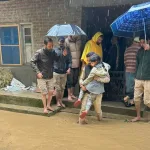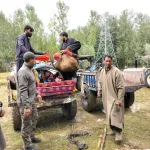INTERNATIONAL DAY OF RURAL WOMEN
Women in rural settings have a tremendous contribution not only towards their families but also in development of societies and the nations to which they belong. They are performing multifaceted roles form home makers to that of nation builders. Women also account for a substantial proportion of the agricultural labour force. A study of International Labour Organization in 2018 reported on an average women make up more than 40 per cent of the agricultural labor force in developing countries ranging from 20 percent in Latin America to 50 percent or more in parts of Africa and Asia. Although, we are already halfway through the Sustainable Development Goals SDGs 2030, yet the world is failing to achieve gender equality. Data reveals that none of the SDG5 indicators related to Gender Equality are met. Domestic violence, Forced marriages, unequal access to health and education and legal rights continues to exacerbate gender inequality.
The International Day of Rural Women celebrated on Oct. 15 every year recognizes the critical role and contribution of rural women, including indigenous women, in enhancing agricultural and rural development, improving food security and eradicating rural poverty. Rural women and girls are leaders in agriculture, food security and nutrition, land, managing natural resource management and unpaid and domestic care work. They are at the frontline at a time when natural resources and agriculture are threatened. Their contribution to the agriculture sector is immense. In fact, globally, one in three employed women works in agriculture. From agriculture to food security, nutrition, land and natural resource management, domestic care and work, rural women are at the forefront and are taking charge by being in the driver’s seat.
Women also collect biomass fuels, manually process food materials, and pump water; eighty percent of households without piped water rely on women and girls for water collection. Despite so much of contribution to the agriculture sector, women farmers’ typically achieve yields 20-30% less than men due to unequal access to productive resources and services. Studies reveal that closing this gender gap could reduce the number of malnourished people by 12-17%. Gender inequity plays a special role within agriculture as women are often pivotal to ensure household food security. Yet, they are often not given access to resources and have little decision-making power. In order to give them a voice, to raise awareness of rural women’s participation in the development process with a focus on their needs and rights, highlighting their contributions to sustainable development, household food security, safeguarding traditional knowledge, biodiversity, and peace building and so much more, a day has been dedicated to these invisible partners of growth. The International Day for Rural Women celebrated every year on Oct. 18 serves a platform for all these activities.
The International Day of Rural Women was created in 1995 by civil society organizations at the Fourth World Conference on Women in Beijing and was declared an official UN Day in 2007 by the UN General Assembly vide its resolution 62/136 of December 18, 2007 to recognize the critical role and contribution of rural women including indigenous women in enhancing agricultural and rural development, improving food security and eradicating rural poverty. On the International Day of Rural Women, UN Women calls for action to support rural women and girls and grow their capacities to respond to climate change through agricultural production, food security, and natural resources management. Mobilizing relevant Non Government Organizations and grassroots women’s groups, organizations, networks and international institutions, as well as the media, to commemorate the Day and celebrate Rural Women Leaders and their communities around the world.
In the aftermath of COVID-19, it has been the rural women that have been hit hard. Women have been at the front lines of responding to the pandemic even as their unpaid care and domestic work increased under lockdowns, mobility restricted, supply chains disrupted, and climate and conflict crises compound COVID-19 impacts. In India, millions of rural women organized in self-help groups had helped to fill acute shortages and gaps by producing masks and hand sanitizers, providing fresh food through community kitchens, offering financial services, and communicating vital COVID-19 information in rural communities. Their efforts to contain the spread of COVID-19 pandemic deserve appreciation, but the hard fact is that rural women are laboring under acutely disadvantageous conditions. Already insufficient infrastructure and services in rural areas have been stretched to the limit; rural women’s invaluable care and productive work during the pandemic has burgeoned, in many places without clean and safe water, sanitation and hygiene, energy supply or healthcare services. This pandemic has also heightened the vulnerability of rural women’s rights to land and resources.
The war in Ukraine has a devastating impact on women and girls worldwide widening gender gaps, increasing rates of food insecurity malnutrition and poverty. It has resulted in a cost of living crisis and well being and stymied progress on the Sustainable Development Goals (SDG). Overall, the progress towards achieving gender equality and empowerment of women has been slow. Discriminatory gender norms and practices impede women’s exercise of land and property rights in most countries. Since women’s land rights are often dependent on their husbands, COVID-19 widows risk disinheritance. Women’s land tenure security is also threatened as unemployed migrants return to rural communities, increasing pressure on land and resources and exacerbating gender gaps in agriculture and food security.
There is an urgent need for gender-responsive investments to expand basic infrastructure, healthcare and care services in rural areas have never been more critical. Bolstering women’s land rights in law and practice can help protect women from displacement and losing their sources of livelihood. This International Day of Rural Women is a key moment to galvanize action by all stakeholders to support rural women and girls to not only rebuild their lives after COVID-19 but increase their resilience to be better prepared to face future crises. The world needs to commit to gender equality while designing various developmental policies and programmes. Improving equity will allow both men and women to have a say in how resources are used. It will also help decision makers to guarantee policies, promote fair access to agriculture and natural resources. Gender, poverty, and institutions are therefore interlinked, and cannot be dealt with independently. We have to identify where, when and how women can gain equitable access to water, land and other natural resources. Our goal of sustainable agriculture rests on the premise that enhancing the decision-making power of women over natural resources can improve agriculture production, enable household food security and ensure long-term benefits.
Let all of us work for their education, health, equal access and their participation and adequate representation in the making of various policies/programmes, enacting laws meant for them so that these can be more inclusive and result in empowerment of rural women.
(The author is Scientist, SKUAST-K and can be reached at [email protected])





